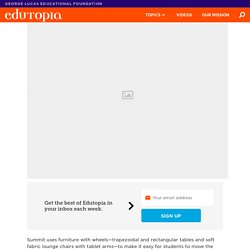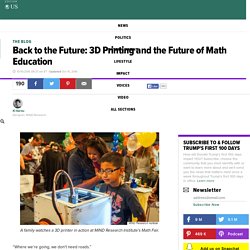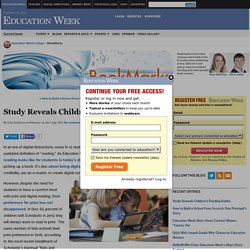

The Optimal Seating Plan? Letting Your Students Choose. How you arrange your seating can be an asset for differentiating instruction.

Summit Preparatory Charter High School in Redwood City, California, uses different seating configurations for independent work, collaborative work, mini lessons, and large-group discussions. Through scaffolded guidance from their teachers—which includes a personalized learning platform, daily goals, and a culture of formative assessment—students understand how they learn best and what resources they need, enabling them to choose and set up the seating arrangement that works best for them each day. Summit uses furniture with wheels—trapezoidal and rectangular tables and soft fabric lounge chairs with tablet arms—to make it easy for students to move the furniture. Used furniture networks, like The Reuse Network, can be great resources, says Myron Kong, a Summit real estate team member, who adds that another way to lower costs when purchasing furniture is to aggregate all school orders into one.
School Snapshot. Edtech: What’s what and what’s coming? We’re surrounded by incredible innovations in technology for education, but the terminology surrounding this and the types of learning made possible can often be confusing.

We throw around terms like “flipped learning” and “gamification”, but what do these actually mean in practice? Flipped learning In a traditional lesson setting, the teacher will try and cram in as much information into an hour as possible, so the main idea behind flipped learning is that teachers can create resources for their students which can be accessed outside of the classroom environment. A great example of this is the use of video. As part of the YouTube generation, young people often watch a great deal of video content on a regular basis; it’s a medium that they are comfortable with, so tapping into this interest can be really beneficial. This “Teachers can use a variety of tools to create video content.”can also have an impact on attitudes towards homework.
Blended learning Augmented reality Gamification. Why so many kids can’t sit still in school today. The Centers for Disease Control tells us that in recent years there has been a jump in the percentage of young people diagnosed with Attention Deficit and Hyperactivity Disorder, commonly known as ADHD: 7.8 percent in 2003 to 9.5 percent in 2007 and to 11 percent in 2011.

The reasons for the rise are multiple, and include changes in diagnostic criteria, medication treatment and more awareness of the condition. In the following post, Angela Hanscom, a pediatric occupational therapist and the founder of TimberNook, a nature-based development program designed to foster creativity and independent play outdoors in New England, suggests yet another reason more children are being diagnosed with ADHD, whether or not they really have it: the amount of time kids are forced to sit while they are in school. This appeared on the TimberNook blog. State-based Prevalence Data of ADHD Diagnosis (2011-2012): Children CURRENTLY diagnosed with ADHD (Centers for Disease Control) By Angela Hanscom local true. To Boost Engagement, Give Tech Savvy Students Interactive Content.
Apps and Websites for Improving Parent-Teacher Communication. Back to the Future: 3D Printing and the Future of Math Education. A family watches a 3D printer in action at MIND Research Institute’s Math Fair.

“Where we’re going, we don’t need roads. . ” - Doc Brown, Back to the Future Thirty years ago, the movie Back to the Future 2 gave us a glimpse of what life would look like on October 21st 2015. The scene that unfolds includes flying cars, robotic pumping gas stations, jackets that dry themselves, and teenagers cruise around town on hover boards. Although the field of 3D printing has its roots in the 1980s, it surged in popularity recently thanks to decreased costs (printers can be found in the thousand dollar range) and people’s astonishingly creative uses of the devices. Study Reveals Children's Reading Habits - BookMarks. In an era of digital distractions, many K-12 students still make time for what some may consider an outdated definition of "reading.

" As Education Week found in a recent special report on what reading looks like for students in today's digital world, literacy for students is not just about picking up a book. It's also about being digitally literate with the ability to assess a website's credibility, use an e-reader, or create digital content themselves. TED Talk. How would you design a school: Graham Brown-Martin at TEDxEastEnd. Learning (Re)Imagined.